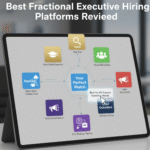Unleashing the Power of Internal Dynamics and Internal Financial Strategies
In the intricate dance of private equity, where every step and turn can significantly impact a firm’s future, mastering the art of effective internal management strategies is not just beneficial – it’s essential. For CFOs in PE-backed firms, the challenge is akin to conducting an orchestra, where each section must harmonize perfectly to create a symphony of success. This is your guide to orchestrating this harmony.
Navigating the complexities of private equity insights requires more than just financial savvy; it demands a deep understanding of the internal mechanisms that drive a company. From the nuanced analysis of financial data to the strategic development of your team, every aspect of internal management plays a pivotal role in steering your firm towards its goals.
In this article, we delve into five critical strategies that can transform your approach to internal management. These strategies are not just about maintaining the status quo; they are about elevating your firm’s internal dynamics to new heights of efficiency and effectiveness. Whether it’s mastering the intricacies of financial data, fostering a culture of continuous learning, or engaging directly with the operational heartbeat of your company, each strategy is a step towards building a stronger, more resilient organization.
1. Master Detailed Financial Strategies and Data Analysis
Deep Dive into Data:
In the world of private equity, surface-level financials, and financial analysis only tell part of the story. As a PE-backed CFO, your ability to dive deep into the financial data is crucial. This means going beyond the basic profit and loss statements to dissect granular data points that can reveal your business’s true health and potential. Key areas to focus on include unit economics, which helps you understand the profitability of individual products or services; customer acquisition costs, which gauge the efficiency and effectiveness of your marketing efforts; and operational efficiencies, which can uncover hidden opportunities for cost reduction and process improvement. By dissecting these elements, you can understand where your company stands and what drives its financial performance.

Developing Financial Strategy Acumen:
This deep dive requires a robust financial strategy acumen, blending traditional accounting knowledge with a keen understanding of business operations. It involves analyzing trends over time, comparing your company’s performance against industry benchmarks, and understanding the implications of various financial ratios and metrics. This level of analysis allows you to spot trends, risks, and opportunities that might otherwise go unnoticed.
Actionable Insights for Strategic Decisions:
The ultimate goal of this detailed analysis is to extract actionable insights that can inform strategic decisions. This might involve identifying the most profitable product lines for expansion, determining the right pricing strategies, or pinpointing inefficiencies in the supply chain that can be optimized. By translating data into insights, you can make informed decisions that align with your company’s strategic objectives and drive long-term profitability.
Driving Profitability through Data-Driven Decisions:
Armed with a detailed financial strategy analysis, you can identify cost-saving opportunities that directly impact the bottom line. This could include renegotiating supplier contracts, optimizing inventory levels, or streamlining operations to reduce waste. By making data-driven decisions, you can enhance operational efficiency, improve cash flow, and ultimately drive profitability in a competitive PE landscape.
2. Implement a Robust Talent Assessment Model
Comprehensive Evaluation:
The cornerstone of a successful finance team in a PE-backed environment is alignment with the company’s strategic goals. To ensure this alignment, it’s crucial to implement a comprehensive talent assessment framework. This framework should evaluate team members on their current performance and their understanding of and adaptability to the necessary changes in the organization. Assess each member’s motivation and commitment to these changes and their capacity to execute them effectively. This involves looking at their skills, experience, and also their potential to grow and adapt in a rapidly changing environment. Consider factors like problem-solving abilities, adaptability to new technologies and processes, and their ability to collaborate and communicate effectively within the team and across the organization.

Tailored Evaluation Criteria:
Develop specific criteria tailored to different roles within the finance team. For instance, financial strategies might be assessed on their ability to interpret data and forecast trends, while a finance manager might be evaluated on their leadership skills and ability to manage cross-functional projects. This tailored approach ensures that each team member is evaluated fairly and accurately based on the expectations and requirements of their specific role.
Development and Training:
Once the evaluation is complete, the next step is to identify areas where team members can develop their skills further. This could involve professional development programs, targeted training sessions, or even mentorship opportunities. Focus on areas that enhance their current performance and prepare them for future challenges and roles within the company. For example, training in data analytics and business intelligence tools would benefit the company if it is moving towards more data-driven decision-making. Similarly, cross-cultural communication and international finance management training might be necessary if the company is expanding globally.
Continuous Learning and Adaptation:
Continuous learning and adaptation are key in the dynamic PE-backed environment. Encourage a culture of ongoing professional development where team members are motivated to keep updating their skills and knowledge. This could be supported through regular training sessions, attendance at industry conferences, or access to online learning platforms. Additionally, it creates opportunities for team members to apply their new skills in real-world scenarios, such as through internal projects or cross-departmental collaborations.
Aligning with Company Growth Trajectory:
Finally, ensure that the development and training of your finance team are aligned with the company’s growth trajectory. This means equipping them with the skills needed for the company’s current operations and preparing them for future expansions, new markets, or changes in business strategy. By doing so, you create a finance team that is not just functional but strategic, contributing significantly to the company’s overall success.
3. CFO Leadership Engage Directly with Operations
Hands-on Approach:
For a PE-backed CFO, having a hands-on approach is crucial for a deep understanding of the business’s inner workings. This involves regularly visiting operational sites, such as manufacturing facilities, retail locations, or service centers, depending on the nature of the business. During these visits, engage directly with frontline employees and managers. This direct interaction provides invaluable insights into the day-to-day challenges, workflow efficiencies, and potential areas for improvement. Observing operations firsthand allows you to see how policies and strategies are implemented on the ground and how they impact productivity and morale.
Understanding Ground Realities:
Being present on the operational floor allows you to witness the realities that may not be apparent from financial reports or board meetings. This could include observing how resources are utilized, understanding the challenges faced by employees in their daily tasks, and identifying bottlenecks or inefficiencies in processes. Such insights are critical for making informed decisions that can enhance operational efficiency and reduce costs.
Customer Interaction:
Direct engagement with customers is another key aspect of understanding the operational efficiency side of the business. This can be achieved through customer visits, sales calls, or industry events and trade shows. Interacting with customers provides first-hand feedback on your company’s products or services, customer satisfaction levels, and market needs. This direct feedback is invaluable for aligning financial strategies with customer expectations and market demands.
Informed Financial Decisions:
The insights gained from direct operational engagement and customer interactions enable you to make more informed financial decisions. Understanding the operational efficiency nuances and customer perspectives helps better forecast, budget, and allocate resources. It also aids in identifying investment opportunities that can improve operational efficiency or enhance customer satisfaction.
Building Relationships and Trust:
Engaging directly with operations and customers also helps in building relationships and trust within the organization. It demonstrates your commitment to understanding the challenges employees face and customers’ needs. This can lead to increased collaboration, open internal communication strategy, and a more cohesive approach to achieving the company’s objectives.
Strategic Initiatives and Innovations:
Finally, the knowledge gained from this direct engagement can be pivotal in driving strategic initiatives and innovations. It can lead to the development of new products, services, or processes that can give the company a competitive edge. It also allows you to identify areas where technology or automation can be implemented for greater efficiency.
4. Compile Essential Financial Templates
Standardization:
In the fast-paced environment of private equity, efficiency and accuracy in financial reporting are paramount. As a PE-backed CFO, one of your key tasks is to develop a suite of standardized financial templates that can be used across various finance department functions. These templates should cover critical areas such as budgeting, forecasting, cash flow analysis, and financial performance analysis. Standardizing these documents ensures that all financial reporting is consistent, which is crucial for accurate analysis and decision-making. Standardized templates also streamline the reporting process, saving valuable time and reducing the likelihood of errors.
Customization for Specific Needs:
While standardization is important, it’s also crucial to ensure that these templates are customizable to meet your organization’s specific needs. They should be flexible enough to accommodate unique aspects of your business, such as specific revenue streams, cost structures, or operational efficiency metrics. This might involve creating different versions of a template for different business units or adding adjustable parameters to cater to varying scenarios.
Best Practices Sharing:
The world of finance is continuously evolving, and so are the best practices in financial management and reporting. Actively engage with your professional network, including other CFO leadership, finance professionals, and industry groups, to share and obtain best-practice templates. This could be through formal networking events, online finance communities, or professional associations. By exchanging templates and insights with your peers, you can continuously refine and enhance your financial strategies toolkit, ensuring that it remains up-to-date with the latest trends and best practices.
Training and Familiarization:
Once you have developed these templates, training your team on how to use them effectively is important. This might involve conducting training sessions, creating user guides, or even one-on-one coaching for specific team members. Ensure that everyone in the finance team understands how to use the templates correctly and knows the importance of maintaining consistency in financial reporting.
Continuous Improvement and Adaptation:
Finally, view your suite of financial templates as a living set of tools that should evolve with your business. Regularly review and update the templates to reflect changes in the business environment, regulatory requirements, or internal company strategies. Encourage feedback from your team on how the templates are working and where improvements can be made. This approach of continuous improvement ensures that your financial templates remain relevant, efficient, and effective in supporting your company’s financial management needs.
5. Establish Comprehensive Investor Feedback Mechanisms
Regular Communication:
Maintaining a consistent and structured communication channel with investors is vital in the dynamic landscape of private equity insights. As PE-backed CFO leadership, you should establish regular interactions with your investors, such as monthly or quarterly meetings, to ensure alignment on expectations, goals, and key performance metrics. These interactions serve as a platform to review financial performance, discuss strategic initiatives, and align on future directions. Preparing for these meetings with detailed reports and analyses is important, offering a clear and concise overview of the company’s financial health and strategic progress.
Setting the Agenda:
Each interaction should have a well-defined agenda, focusing on critical aspects of the business, such as revenue growth, cost management, capital allocation, and strategic investments. This helps in keeping the discussions focused and productive. It’s also beneficial to include updates on any significant market changes or external factors that might impact the business, ensuring that investors are fully informed about the company’s operating environment.
Feedback Loop:
Utilize these regular interactions as a two-way feedback loop. While you provide investors with updates on the company’s financial performance and strategic initiatives, also seek their insights and advice. Investors often bring a wealth of experience and can offer valuable perspectives on market trends, risk management, and strategic opportunities. Encourage open and honest discussions where feedback is given and actively sought. This collaborative approach can lead to more informed decision-making and stronger investor relations.
Actionable Insights and Adjustments for Effective Internal Management Strategies:
After each interaction, take the time to reflect on the feedback and insights provided by the investors. Evaluate how this feedback can be translated into actionable steps for your company. This might involve adjusting financial strategies, reallocating resources, or even rethinking certain business model aspects. The key is to be responsive and adaptable, using investor feedback to refine and improve your company’s strategies and operations continuously.
Transparency and Trust:
Establishing a comprehensive investor feedback mechanism is not just about sharing information; it’s about building transparency and trust. By engaging in regular, open dialogues with your investors, you demonstrate a commitment to transparency and accountability. This helps build a strong trust foundation, which is crucial for navigating the challenges and opportunities in the private equity space.
Harmonizing the Internal Symphony for PE Success
As we reach the finale of “5 Effective Internal Management Strategies for PE-Backed CFOs,” it’s clear that the role of CFO leadership in a private equity setting is much like that of a skilled conductor, orchestrating a complex symphony of internal operations. Each strategy we’ve explored is akin to a distinct section of an orchestra, playing a crucial role in your firm’s overall performance.
You fine-tune the strings section by mastering detailed financial data analysis, ensuring each note resonates with clarity and precision. Implementing a robust talent assessment model is like harmonizing the brass section, with each member contributing their unique strength to the collective sound. Engaging directly with operations allows you to feel the rhythm of the percussion and understand the core beat that drives your company forward. Compiling essential financial templates is akin to arranging the woodwinds, bringing structure and flow to your financial reporting. Finally, establishing comprehensive investor feedback mechanisms ensures that the entire orchestra plays in unison, aligned with the expectations and goals of your audience – the investors.
As you apply these strategies, remember that your role is to bring harmony and balance to the internal dynamics of your firm. Just as a conductor leads their orchestra to a standing ovation, your leadership and strategic vision can guide your PE-backed firm to new heights of success and acclaim. Embrace the challenge, wield your baton with confidence, and watch as the symphony of your firm’s internal management plays out a masterpiece of efficiency, growth, and resilience in the ever-evolving world of private equity.







